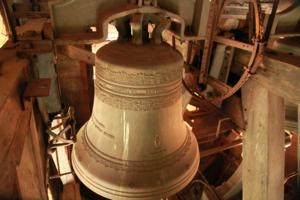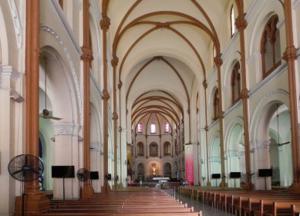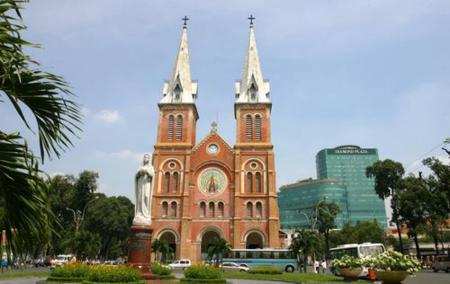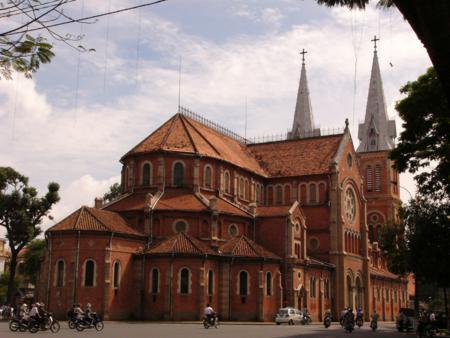Duc Ba cathedral (official name: The Basilica of St. Mary of the Immaculate conception) is the main cathedral of Archdiocese of Ho Chi Minh city. This is also a Catholic Church with large scale and distinction, one of the buildings attract the most visitors in this city.
Duc Ba Cathedral was built on October 7th, 1877 by Bishop Isodore Comlombert placing the first brick in front of the deputy marshal and high-ranking cadre of the South Vietnam. The Cathedral was built for 3 years. Easter, April 11, 1880, the dedication and inauguration ceremony was held successfully by Catholic priest Colombert with the presence of Governor of the South Vietnam – Le Myre.
Originally, this work item is known as a great architecture in the Paris Commune Square, city center, with two bell tower of 40 meter in height. Besides honourable names such as the Cathedral, State Cathedral, Saigon Cathedral, it has added another name is Notre Dame Cathedral. Through many vicissitudes of history, Notre Dame Cathedral gradually became a symbol of the city center.
During construction, all building materials such as cement, iron and steel, screws,… are bought from France. The outside of the building was built by bricks that is made at Marseille, not plastered (it remained pink color until now), not dusty moss. There is the words Guichard carvin, Marseille St André France on some broken tiles in Cathedral (perhaps, it means place for production of tiles), another tile is with the words Wang-Tai Saigon. It may be a piece of tile that is manufactured in Saigon, they are used to replace the broken tiles during the second world war. The whole cathedral has 56 stained glass doorways by Lorin firm of Chartres province (France) produce.
 The foundation of the Sanctuary was designed specially, to withstand loads up to 10 times of entire church architecture located above. And a very special thing that the Church does not have fence or wall as other church around Saigon – Gia Dinh area then and now.
The foundation of the Sanctuary was designed specially, to withstand loads up to 10 times of entire church architecture located above. And a very special thing that the Church does not have fence or wall as other church around Saigon – Gia Dinh area then and now.
Furniture of Cathedral has two main pillars of rectangles, 6 pillars for each side that symbolize 12 apostles Gods. Immediately behind of main pillars is a corridor and many small chapels with small altars (more than 20) and small statues of saints that are made by white rock. The altar in Saint palace is made by marble monolith with six angles carved into the stone. The wall are decorated with 56 glass doorways that describe the characters or events in the Bible, 31 roses in round shape, 25 bullseye windows that are joyed by multicolored glass with very beautiful images. All lines, pattern complies with Roman and Gothic form, elegant and sanctuary. However, only 4 in 56 glass doorways are intact up to now, while the other stained glass window has been reworked in 1949 to replace the original stained glass window of the church was broken near the end of World war 2.
The biggest three bell are Si bell of 4,184kg, La bell of 5,931kg and especially Sol bell – one of the biggest bell on over the world: 8,785kg in weight, bell mouth is 2.25m in diameter, 3.5 in height. This bell only ring once a year on Lunar New Year’s Eve. The bells are electronically controlled from below. Particularly three big bells, before ringing, they are booted by bike (because of too heavy) in order to shake before turning the power switch. On weekdays, the Church just ring a Mi bell at 5AM and 16:15PM. On holidays and Sundays, the Church often ring 3 bells according to accord Mi, Re and Do (in fact, it’s accord of Mi, Do and Sol, but Sol bell is too heavy so they use Do bell instead of Sol bell). On Lunar New Year’s Eve, ring all of 6 bells. The bells could be as far as 10 km according to the crow flies.
 The clock machine at the front of arch roof is high from the ground about 15m, between two bell towers was built in Switzerland in 1887, RA brand, approximately 2.5m in height, 3m in length, heavier 1 ton, located on brick pedestals. Although rudimentary and old, it works fairly accurate. In order to adjust the clock, there is a clock-sized family behind of machine. Just follow this small clock, you may know the big clock runs slow, fast, right or wrong time. Each week, they have to recharge the big clock once time.
The clock machine at the front of arch roof is high from the ground about 15m, between two bell towers was built in Switzerland in 1887, RA brand, approximately 2.5m in height, 3m in length, heavier 1 ton, located on brick pedestals. Although rudimentary and old, it works fairly accurate. In order to adjust the clock, there is a clock-sized family behind of machine. Just follow this small clock, you may know the big clock runs slow, fast, right or wrong time. Each week, they have to recharge the big clock once time.
In front of the Cathedral is a park with 4 streets intersect to form the Cross shape. The centre of the park is the statue of our lady of peace (or peace Queen). This statue was made by sculptor – G.Ciocchetti in 1959.
Standing the front of main altar of Cathedral, we can see big wooden wall. That is a place be called “placing musical intrument” and that wooden wall itself is organ, one of two the oldest piano in Vietnam today, according to priest Vuong si Tuan. This Organ was handmade by foreign experts, so it’s sound is enough for whole cathedral to hear, not small but not too noisy.
Estimate, the body is 3 m in height, 2m in length, containing aluminum tubes with diameter of one inch. The controlled part of the organ is separated and connect with body part by axis. Normal organ keyboards are played by hand and big organ keyboards are placed on the floor (3m in length, 1m in width) in order to organ player stamp when using low musical notes.
Inside the organ is designed similar to Piano but more complex. This organ has big bars to beat on the bottom of sound tubes, similar to playing K’lông pút of Bahnar people in Vietnam (a traditional bamboo xylophone). According to Mr Nam Hai – person in charge of the music in the Cathedral, in order to play this organ, the player must be studied separately because there is no training school up to now.
There is not any places for candles in this cathedral. The entire lamps was available since built time – all of them are electric lamps. Starting from October 7th, 1877 to April 11th, 1880 was completed, the Cathedral is also the resting place of many bishops and priests of the diocese, in which including Bishop Isodore Colombert – who laid the first stone and inauguration of Cathedral, he dead in 1894.
Contact details:
Address: No 1 Cong Xa Pari street, District 1, Ho Chi Minh city
Phone: (08) 3822 0477 – (08) 3829 4822


